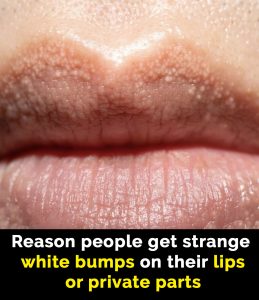The human body is an incredibly intricate system, always changing and adapting. While some of these changes occur gradually and almost imperceptibly, others can appear seemingly overnight, catching us off guard. These sudden developments can be harmless, but it’s always wise to stay aware of your body and any new symptoms or physical changes. Being informed helps you identify when something may be normal—or when it might require professional attention.

One such change that causes concern for many people is the sudden appearance of small white bumps, either on the lips or around the genitals. If you’ve noticed these, you’re not alone. In fact, medical experts estimate that between 70% and 80% of adults experience this phenomenon at some point. These bumps are typically white or pale and are commonly mistaken for something more serious. However, in most cases, they are something entirely harmless known as Fordyce spots.
According to the Cleveland Clinic, Fordyce spots are a benign skin condition where oil glands become more visible. They’re not caused by an infection or illness, and they’re certainly not sexually transmitted. These spots can appear on the border of your lips, inside your cheeks, and in the genital area, including the penis and vulva. They are more noticeable during and after puberty and tend to become less prominent over time. For most people, they pose no health risk and require no treatment.
The Cleveland Clinic notes, “They often appear on and around your lips and sometimes on your penis and vagina. They’re a natural part of your skin, but treatments can shrink or remove them.” While there’s no clear cause behind the development of Fordyce spots, they are considered a natural part of human anatomy. Most people are born with them, and they simply become more noticeable during hormonal changes such as puberty.
In terms of treatment, Fordyce spots usually go away on their own without medical intervention. However, for those who are self-conscious or uncomfortable with their appearance, there are options to reduce or remove them. Over-the-counter retinoid creams or other topical treatments can help lessen their appearance over time. If a faster solution is desired, there are medical procedures that can be performed, including micro-punch surgery, cryotherapy (freezing), electrodesiccation (using electric current), and laser skin resurfacing. These treatments, while effective, may involve a consultation with a dermatologist or a skin care specialist to discuss potential side effects and outcomes.
It’s also important to address a common fear—many people worry these white bumps are genital warts or a sign of a sexually transmitted infection (STI). Fortunately, Fordyce spots are not contagious and are not related to any STI or STD. Unlike genital warts, which are caused by the human papillomavirus (HPV) and can spread through sexual contact, Fordyce spots are not infectious and pose no risk of transmission to others.
“People with genital warts develop small bumps or growths in and around their genitals and rectum,” the Cleveland Clinic explains. “Genital warts and HPV are both highly contagious.” At first glance, genital warts may look similar to Fordyce spots, which is why people sometimes panic when they see small bumps in these areas. That’s why a professional diagnosis can be helpful. Although Fordyce spots typically don’t require a medical evaluation, if you ever notice new or rapidly changing bumps on your genitals, it’s a good idea to see a healthcare provider. This ensures that more serious conditions are ruled out and gives you peace of mind.
Learning about Fordyce spots is a reminder of how misunderstood certain aspects of our health can be. Because these bumps are so common yet rarely discussed, many people are left confused or even embarrassed when they notice them. Education is key. Understanding what’s happening with your body empowers you to make smart health decisions without unnecessary fear.
Did you already know about Fordyce spots? If so, you’re ahead of the curve. But if this is your first time learning about them, you’re not alone. Many people are surprised to learn just how common and harmless they are. That’s why it’s important to talk about these things—so others can be informed and avoid unnecessary worry.
If you think someone you know might benefit from this information, don’t hesitate to share it. You never know who might be silently struggling with concern over these little white bumps, thinking they’re alone or fearing something far worse. Raising awareness not only reduces stigma but also promotes a healthier, more open dialogue around our bodies and what’s normal.
The takeaway is simple: Fordyce spots are a natural part of being human. They’re not harmful, they’re not contagious, and they usually don’t require any treatment. But if they bother you or you’re unsure about what you’re seeing, it’s always okay to check in with a healthcare provider for reassurance. Knowing your body is one of the best forms of self-care.
So the next time you notice a sudden change, don’t jump to the worst conclusion. Instead, pause, educate yourself, and when in doubt—ask a professional. You might just find that what seemed alarming at first is nothing more than a harmless feature of your wonderfully unique body.





